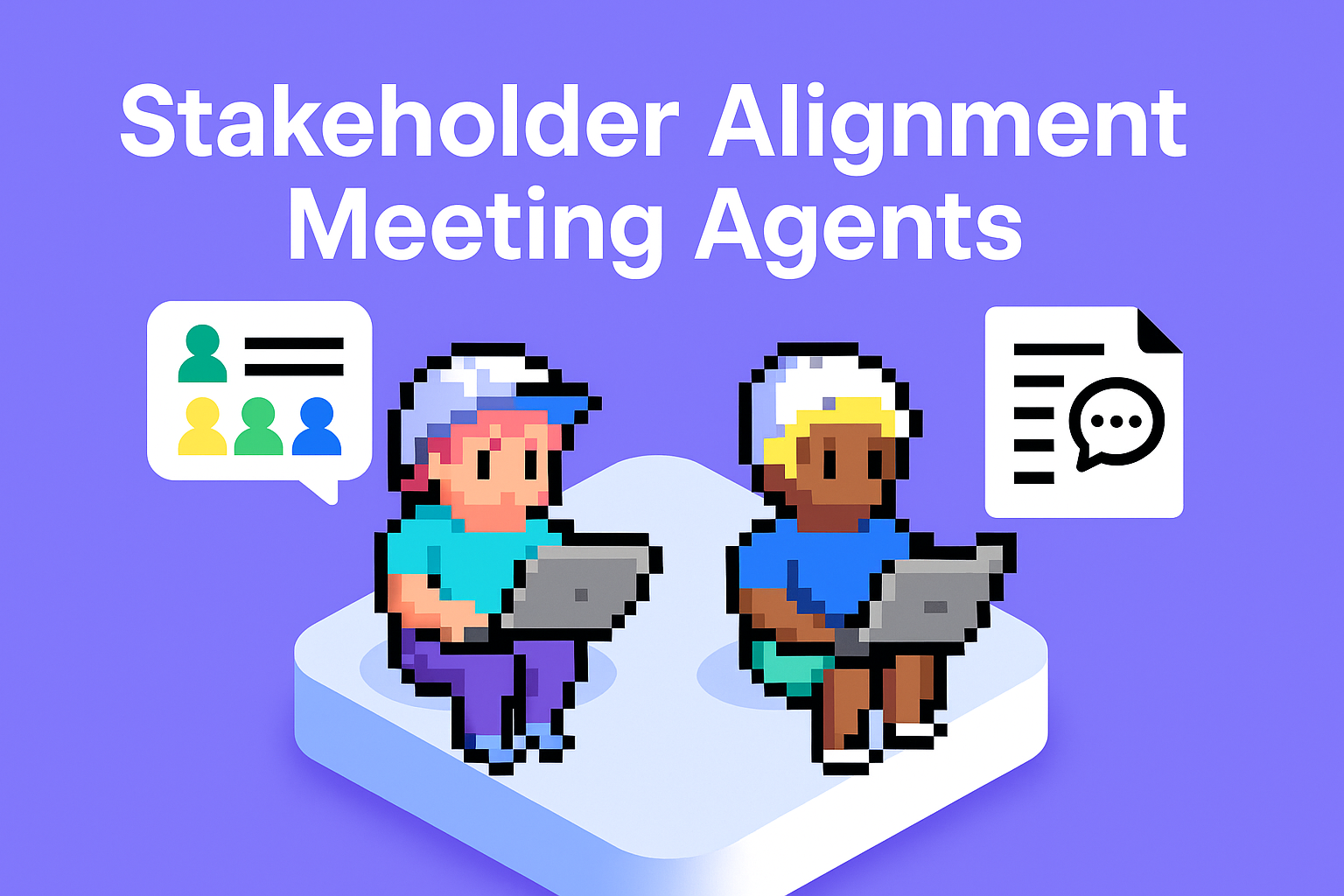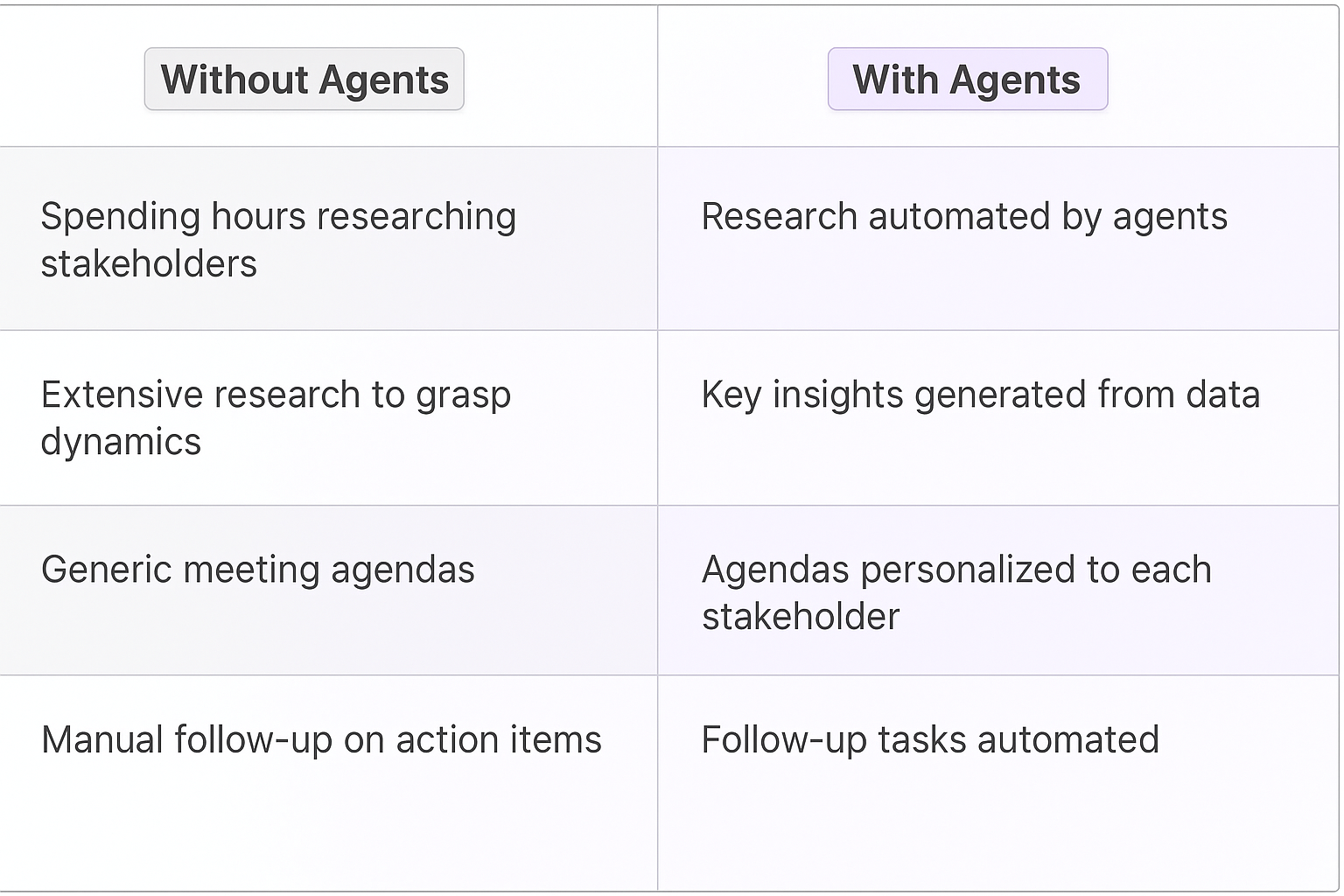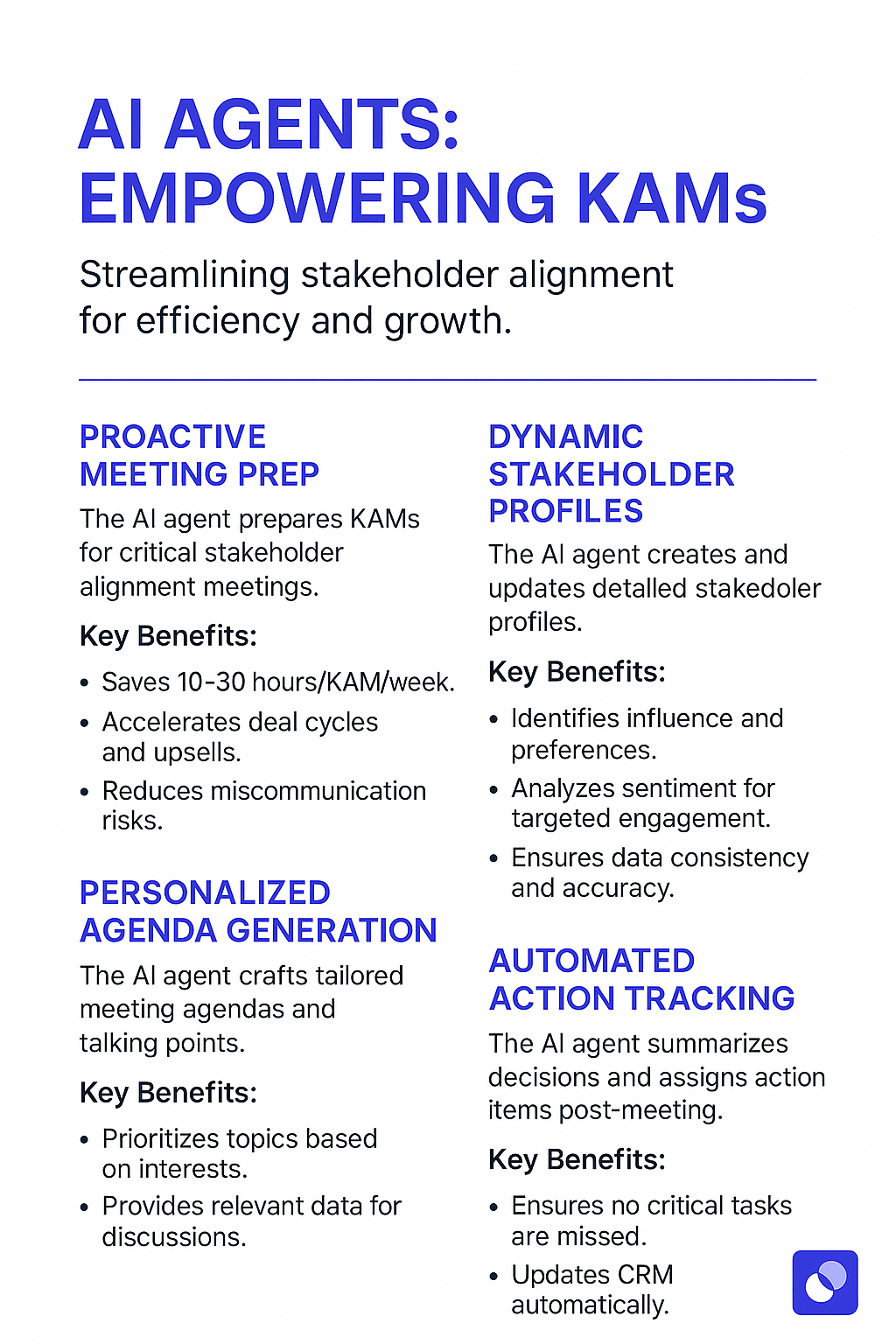
AI-powered stakeholder alignment meeting agents are revolutionizing how key account managers navigate complex client relationships, coordinate with internal teams, and optimize their time. These agents automate the tedious aspects of stakeholder analysis and meeting preparation, allowing managers to focus on building rapport, addressing concerns, and driving consensus. This technology streamlines workflows, reduces miscommunication, and enhances overall client satisfaction.
Before Meeting
Your AI agent analyzes communication histories and organizational charts to identify key stakeholders, their influence, and potential areas of conflict. You enter the meeting with a clear understanding of the stakeholder landscape.
During Meeting
As the meeting progresses, your AI agent provides real-time guidance on managing group dynamics, suggesting compromise solutions, and ensuring all voices are heard. This keeps the meeting focused and productive.
After Meeting
Post-meeting, your AI agent summarizes key decisions, assigns action items, and tracks progress, ensuring accountability and momentum. This helps you stay on top of stakeholder expectations and drive projects forward.
What you’ll need
You don't need to be a developer to set up this integration. Follow this simple guide to get started:
- Meeting Notetaker Agent template
- Calendar account
- Meetings to join
- Relevance AI Account

Who this agent is for
This agent is designed for key account managers, client relationship managers, sales directors, and anyone responsible for managing and aligning stakeholders within key accounts. It's ideal for individuals and teams who frequently conduct meetings with multiple stakeholders from different departments, levels, and backgrounds. Whether you're managing a single large account or multiple smaller accounts, this agent simplifies stakeholder alignment and ensures everyone is working towards the same goals.
How this agent makes stakeholder alignment easier
Automate stakeholder mapping and analysis
Instead of manually researching and mapping stakeholder relationships, the agent automatically analyzes communication patterns, organizational charts, and other data sources to identify key players, their influence, and their priorities. This saves significant time and provides valuable insights.
Personalize meeting agendas and talking points
The agent creates customized meeting agendas and talking points for each stakeholder, based on their individual interests, concerns, and communication styles. This ensures that every participant feels heard and understood.
Facilitate productive discussions and decision-making
During meetings, the agent provides real-time guidance on managing group dynamics, suggesting compromise solutions, and ensuring that all voices are heard. This helps to keep the meeting focused and productive.
Track action items and follow-up on commitments
The agent automatically tracks action items and follow-up on commitments, ensuring that everyone is accountable and that projects stay on track. This reduces the risk of miscommunication and delays.
Benefits of AI Agents for Key Account Managers
What would have been used before AI Agents?
Key account managers traditionally relied on manual methods, such as spreadsheets, CRM systems, and personal notes, to track stakeholder information and manage alignment meetings. This process was time-consuming, prone to errors, and often resulted in miscommunication and missed opportunities. They would spend valuable time researching stakeholders, preparing meeting agendas, and following up on action items, taking away from their core responsibilities of building relationships and driving revenue.
What are the benefits of AI Agents?
AI agents offer a streamlined and automated approach to stakeholder alignment, freeing up key account managers to focus on more strategic tasks. The most significant benefit is the time saved by automating the stakeholder mapping and analysis process. The agent handles everything from identifying key players to creating personalized meeting agendas, reducing the administrative burden on the manager.
AI agents also minimize miscommunication by providing real-time guidance during meetings and tracking action items. This ensures that everyone is on the same page and that projects stay on track. Furthermore, the agent improves stakeholder engagement by personalizing communication and addressing individual concerns.
By integrating with existing CRM systems and other tools, the agent provides a seamless and user-friendly experience. This eliminates the need for manual data entry and ensures that all stakeholder information is accurately recorded and easily accessible. Ultimately, AI agents enhance productivity, reduce stress, and allow key account managers to focus on building strong client relationships and driving business growth.
Traditional vs Agentic meeting planning
Traditionally, key account managers spent hours each week manually researching stakeholders and preparing for alignment meetings. Now, AI agents automate this, freeing up time for building relationships. Before, understanding stakeholder dynamics required extensive research and guesswork. With an agent, key insights are readily available, based on data analysis. Meeting agendas used to be generic and one-size-fits-all. Now, they're personalized to each stakeholder's interests. Following up on action items was a manual task, often overlooked. Now, it's automated, ensuring accountability. Finally, tracking stakeholder information was scattered across different systems. The agent centralizes everything, providing a holistic view.

Tasks that can be completed by a Stakeholder Alignment Agent
Key account managers juggle numerous tasks, from building relationships to negotiating contracts and managing projects. A stakeholder alignment agent can handle many of the administrative and analytical tasks associated with stakeholder management, allowing managers to focus on their core responsibilities.
Identifying Key Stakeholders
The agent analyzes communication patterns, organizational charts, and other data sources to identify key stakeholders and their level of influence.
Analyzing Stakeholder Interests and Concerns
The agent researches stakeholder backgrounds, communication styles, and past interactions to understand their individual interests and concerns.
Creating Personalized Meeting Agendas
The agent generates customized meeting agendas for each stakeholder, based on their individual interests and concerns.
Providing Real-Time Guidance During Meetings
During meetings, the agent provides real-time guidance on managing group dynamics, suggesting compromise solutions, and ensuring that all voices are heard.
Tracking Action Items and Follow-Up
The agent automatically tracks action items and follow-up on commitments, ensuring that everyone is accountable and that projects stay on track.
Updating CRM Systems with Stakeholder Information
The agent automatically updates CRM systems with stakeholder information, ensuring that all data is accurate and up-to-date.
Generating Stakeholder Reports
The agent generates reports on stakeholder engagement, alignment, and satisfaction, providing valuable insights for decision-making.

Things to Keep in Mind When Building a Stakeholder Alignment Agent
Building an effective stakeholder alignment agent requires careful planning and attention to detail. The goal is to create an agent that seamlessly integrates with your existing workflows and provides a user-friendly experience for all participants.
Define Clear Objectives
Before you start building your agent, define clear objectives for what you want it to achieve. Do you want to reduce meeting preparation time, improve stakeholder engagement, minimize miscommunication, or all of the above? Having clear objectives will help you prioritize features and measure success.
Integrate with Existing CRM Systems and Tools
Ensure that your agent integrates seamlessly with popular CRM systems like Salesforce, HubSpot, and other stakeholder management tools. This will make it easier for users to adopt the agent and incorporate it into their daily routines.
Prioritize User Experience
Make sure that the agent is easy to use and intuitive. The interface should be clean and uncluttered, and the stakeholder analysis process should be straightforward and efficient.
Automate Reminders and Follow-Ups
Configure the agent to send automated reminders and follow-up emails to keep stakeholders informed and engaged. This will help reduce miscommunication and ensure that everyone is aware of their responsibilities.
Handle Sensitive Information Securely
Ensure that the agent handles sensitive stakeholder information securely and in compliance with all applicable privacy regulations. This is especially important when dealing with confidential client data.
Provide Customizable Settings
Allow users to customize the agent's settings to match their preferences. This might include setting preferred communication styles, specifying notification preferences, and choosing which CRM systems to integrate with.
Test Thoroughly
Before you roll out the agent to your entire team, test it thoroughly to ensure that it is working correctly and that it meets your objectives. Gather feedback from users and make any necessary adjustments.
Continuously Improve
Once your agent is live, continue to monitor its performance and gather feedback from users. Use this information to identify areas for improvement and make ongoing enhancements.
The Future of AI Agents in Stakeholder Alignment
The future of AI agents in stakeholder alignment is bright, with advancements in natural language processing, machine learning, and artificial intelligence promising to further streamline and enhance the stakeholder management process. Future agents will be able to understand complex stakeholder relationships, anticipate potential conflicts, and proactively suggest solutions.
AI agents will also become more personalized, learning individual stakeholder preferences and tailoring their recommendations accordingly. They will be able to identify preferred communication styles, preferred meeting times, and even preferred negotiation tactics, creating a more seamless and user-friendly experience.
Furthermore, AI agents will play a larger role in facilitating collaboration and communication during meetings. They will be able to transcribe meeting minutes, track action items, and even provide real-time translation services, making meetings more productive and inclusive.
AI agents will also integrate with other business applications, such as project management tools and CRM systems, providing a holistic view of stakeholder management activities and enabling better decision-making.
Ultimately, the future of AI agents in stakeholder alignment is about creating intelligent systems that not only automate the stakeholder management process but also enhance collaboration, improve communication, and drive better business outcomes.









